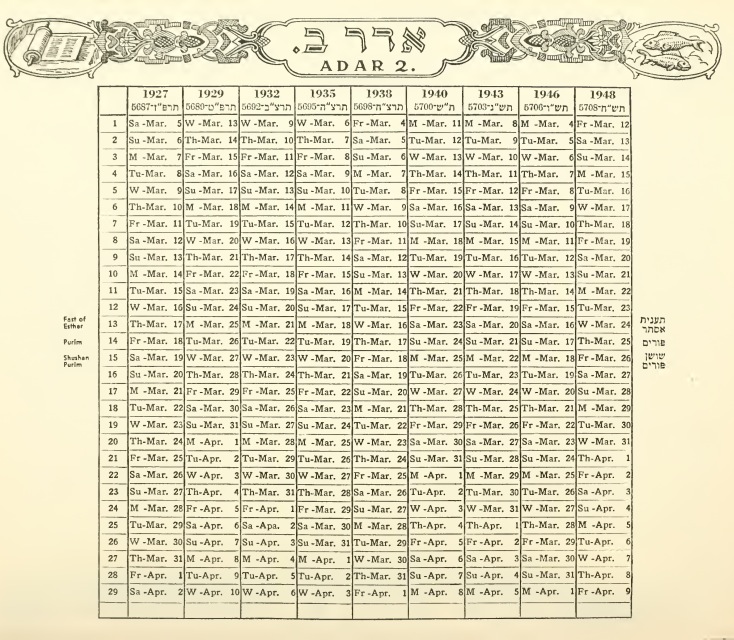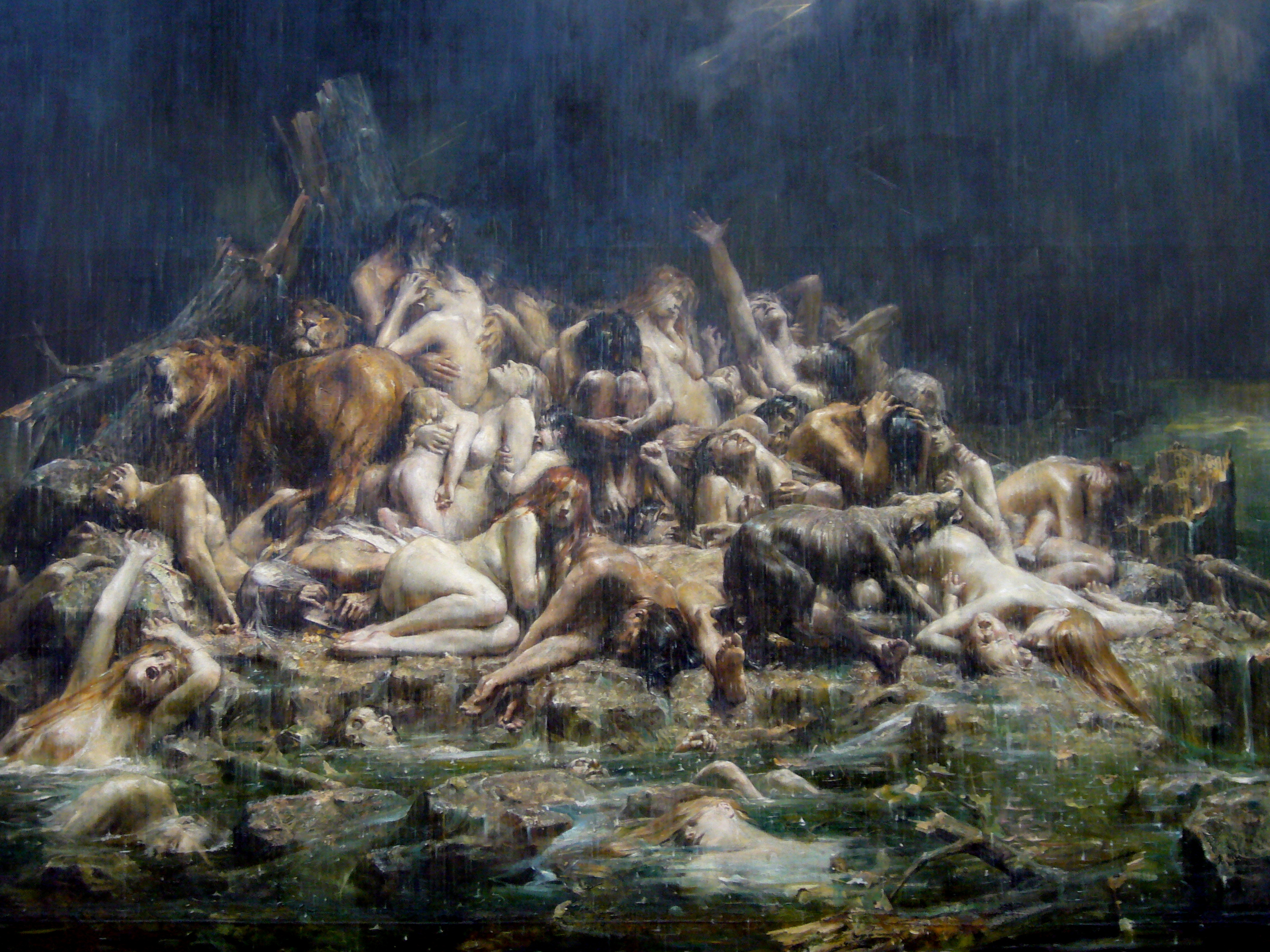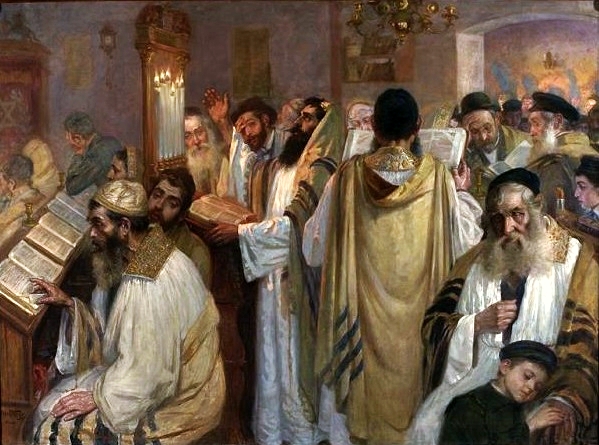|
Marcheshvan
Marcheshvan ( he, מַרְחֶשְׁוָן, Standard , Tiberian ; from Akkadian , literally, 'eighth month'), sometimes shortened to Cheshvan (, Standard Tiberian ), is the second month of the civil year (which starts on 1 Tishrei), and the eighth month of the ecclesiastical year (which starts on 1 Nisan) on the Hebrew calendar. In a regular () year, Marcheshvan has 29 days, but because of the Rosh Hashanah postponement rules, in some years, an additional day is added to Marcheshvan to make the year a "full" () year. Marcheshvan occurs in October–November in the Gregorian calendar. The Hebrew Bible, before the Babylonian Exile, refers to the month as Bul (). In Sidon, the reference to is also made on the Sarcophaugus of Eshmunazar II dated to the early 5th century BC. Etymology Compared to its Akkadian etymon , the name displays the same lenition of ungeminated to found in other month names (Tammuz traditionally contains mem with dagesh). Uniquely to this name the initi ... [...More Info...] [...Related Items...] OR: [Wikipedia] [Google] [Baidu] |
Hebrew Calendar
The Hebrew calendar ( he, הַלּוּחַ הָעִבְרִי, translit=HaLuah HaIvri), also called the Jewish calendar, is a lunisolar calendar used today for Jewish religious observance, and as an official calendar of the state of Israel. It determines the dates for Jewish holidays and the appropriate Torah reading, public reading of Weekly Torah portion, Torah portions, ''yahrzeits'' (dates to commemorate the death of a relative), and daily Psalm readings, among many ceremonial uses. In Israel, it is used for religious purposes, provides a time frame for agriculture, and is an official calendar for civil holidays, alongside the Gregorian calendar. The present Hebrew calendar is the result of a process of development, including a Babylonian calendar, Babylonian influence. Until the Tannaitic period (approximately 10–220 Common Era, CE), the calendar employed a new lunar phase, crescent moon, with an Intercalation (timekeeping), additional month normally added every two or ... [...More Info...] [...Related Items...] OR: [Wikipedia] [Google] [Baidu] |
Sigd
Mehlella ( gez, ምህላ, , Supplication), also Amata Saww (, 'Grouping Day') or Sigd (, 'Prostration', he, סיגד, also romanized ''Sig'd''), is one of the unique holidays of the Beta Israel (Ethiopian Jewish) community, and is celebrated on the 29th of the Hebrew month of Marcheshvan. Since 2008, it has been an official Israeli state holiday. Date Previously, Sigd was celebrated on the 29th of Kislev, and after a calendar reform in the mid-19th century it was moved to its present day, 50 days after Yom Kippur. Etymology The word ''Sigd'' itself is Ge'ez for "prostration" and is related to arc, סְגֵד ''sgēd'' "to prostrate oneself (in worship)". The Semitic root √sgd is the same as in ''mesgid'', one of the two Beta Israel Ge'ez terms for "synagogue" (etymologically related to ar, مَسْجِد ''masjid'' "mosque", literally "place of prostration"), and from the same Semitic root we also have the Hebrew verb לסגוד ''lisgod'', "to worship". Significance The ... [...More Info...] [...Related Items...] OR: [Wikipedia] [Google] [Baidu] |
Genesis Flood Narrative
The Genesis flood narrative (chapters 6–9 of the Book of Genesis) is the Hebrew version of the universal flood myth. It tells of God's decision to return the universe to its pre- creation state of watery chaos and remake it through the microcosm of Noah's ark. The Book of Genesis was probably composed around the 5th century BCE, although some scholars believe that Primeval history (chapters 1–11), including the flood narrative, may have been composed and added as late as the 3rd century BCE. It draws on two sources, called the Priestly source and the non-Priestly or Yahwist, and although many of its details are contradictory, the story forms a unified whole. A global flood as described in this myth is inconsistent with the physical findings of geology, paleontology, and the global distribution of species. A branch of creationism known as flood geology is a pseudoscientific attempt to argue that such a global flood actually occurred. Some Christians have preferred to int ... [...More Info...] [...Related Items...] OR: [Wikipedia] [Google] [Baidu] |
Metathesis (linguistics)
Metathesis (; from Greek , from "I put in a different order"; Latin: ''transpositio'') is the transposition of sounds or syllables in a word or of words in a sentence. Most commonly, it refers to the interchange of two or more contiguous segments or syllables, known as adjacent metathesis or local metathesis: * ''foliage'' > ''**foilage'' (adjacent segments) * ''anemone'' > ''**anenome'' (adjacent syllables) * ''cavalry'' > ''**calvary'' (codas of adjacent syllables) Metathesis may also involve interchanging non-contiguous sounds, known as nonadjacent metathesis, long-distance metathesis, or hyperthesis, as shown in these examples of metathesis sound change from Latin to Spanish: * Latin > Spanish "word" * Latin > Spanish "miracle" * Latin > Spanish "danger, peril" * Latin > Spanish "crocodile" Many languages have words that show this phenomenon, and some even use it as a regular part of their grammar, such as Hebrew and Fur. The process of metathesis has altered the ... [...More Info...] [...Related Items...] OR: [Wikipedia] [Google] [Baidu] |
Shavuot
(''Ḥag HaShavuot'' or ''Shavuos'') , nickname = English: "Feast of Weeks" , observedby = Jews and Samaritans , type = Jewish and Samaritan , begins = 6th day of Sivan (or the Sunday following the 6th day of Sivan in Karaite Judaism) , ends = 7th (in Israel: 6th) day of Sivan , celebrations = Festive meals. All-night Torah study. Recital of Akdamut liturgical poem in Ashkenazic synagogues. Reading of the Book of Ruth. Eating of dairy products. Decoration of homes and synagogues with greenery (Orach Chayim494. , significance = One of the Three Pilgrimage Festivals. Celebrates the revelation of the Five Books of the Torah by God to Moses and to the Israelites at Mount Sinai, 49 days (seven weeks) after the Exodus from ancient Egypt. Commemorates the wheat harvesting in the Land of Israel. Culmination of the 49 days of the Counting of the Omer. , relatedto = Passover, which precedes Shavuot , date = , date = , date = , date = ... [...More Info...] [...Related Items...] OR: [Wikipedia] [Google] [Baidu] |
Passover
Passover, also called Pesach (; ), is a major Jewish holidays, Jewish holiday that celebrates the The Exodus, Biblical story of the Israelites escape from slavery in Ancient Egypt, Egypt, which occurs on the 15th day of the Hebrew calendar, Hebrew month of Nisan, the first month of Aviv, or spring. The word ''Pesach'' or ''Passover'' can also refer to the Passover sacrifice, Korban Pesach, the paschal lamb that was offered when the Temple in Jerusalem stood; to the Passover Seder, the ritual meal on Passover night; or to the Feast of #Matzah, Unleavened Bread. One of the biblically ordained Three Pilgrimage Festivals, Passover is traditionally celebrated in the Land of Israel for seven days and for eight days among many Jews in the Jewish diaspora, Diaspora, based on the concept of . In the Bible, the seven-day holiday is known as Chag HaMatzot, the feast of unleavened bread (matzo). According to the Book of Exodus, God commanded Moses to tell the Israelites to mark a lamb's bl ... [...More Info...] [...Related Items...] OR: [Wikipedia] [Google] [Baidu] |
Yom Kippur
Yom Kippur (; he, יוֹם כִּפּוּר, , , ) is the holiest day in Judaism and Samaritanism. It occurs annually on the 10th of Tishrei, the first month of the Hebrew calendar. Primarily centered on atonement and repentance, the day's observances consist of full fasting and ascetic behavior accompanied by intensive prayer as well as sin confessions (traditionally inside of a synagogue). Alongside the related holiday of Rosh HaShanah, Yom Kippur is one of the two components of the "High Holy Days" of Judaism. Etymology () means "day" in Hebrew and () is translated to "atonement". The common English translation of Yom Kippur is Day of Atonement; however, this translation lacks precision. The name Yom Kippur is based on the Torah verse, "...but on the 10th day of the seventh month it is the day of ''kippurim'' unto you..." The literal translation of ''kippurim'' is cleansing. Yom Kippur is a Jewish day to atone for misdeeds and become cleansed and purified from the ... [...More Info...] [...Related Items...] OR: [Wikipedia] [Google] [Baidu] |
Beta Israel
The Beta Israel ( he, בֵּיתֶא יִשְׂרָאֵל, ''Bēteʾ Yīsrāʾēl''; gez, ቤተ እስራኤል, , modern ''Bēte 'Isrā'ēl'', EAE: "Betä Ǝsraʾel", "House of Israel" or "Community of Israel"), also known as Ethiopian Jews ( he, יְהוּדֵי אֶתְיוֹפְּיָה: ''Yehudey Etyopyah;'' Ge'ez: የኢትዮጵያ አይሁድዊ, ''ye-Ityoppya Ayhudi''), are a Jewish community that developed and lived for centuries in the area of the Kingdom of Aksum and the Ethiopian Empire, which is currently divided between the modern-day Amhara and Tigray regions of Ethiopia. Most of the Beta Israel community immigrated to Israel in the late 20th century. The Beta Israel lived in northern and northwestern Ethiopia, in more than 500 small villages which were spread over a wide territory, alongside populations that were Muslim and predominantly Christian. Most of them were concentrated mainly on what are today North Gondar Zone, Shire Inda Selassie, Wolqayit, T ... [...More Info...] [...Related Items...] OR: [Wikipedia] [Google] [Baidu] |
Iyar
Iyar ( he, אִייָר or , Standard ''ʾĪyyar'' Tiberian ''ʾĪyyār''; from akk, 𒌗 𒄞 itiayari " rosette; blossom") is the eighth month of the civil year (which starts on 1 Tishrei) and the second month of the Jewish religious year (which starts on 1 Nisan) on the Hebrew calendar. The name is Babylonian in origin. It is a month of 29 days. Iyar usually falls in April–May on the Gregorian calendar. In the Hebrew Bible, before the Babylonian captivity, the month was called Ziv (, ). Ziv is a Hebrew word that means "light" or "glow". Along with all other current, post-biblical Jewish month names, Iyar was adopted during the Babylonian captivity. In the Babylonian calendar its name was Araḫ Āru, which can be interpreted as "month of blossoming". Holidays in Iyar Jewish holidays * 14 Iyar – Pesach Sheni * 18 Iyar – Lag BaOmer * Fast of Behav – see Cheshvan. It is observed on the Monday, Thursday, and Monday after the first Sabbath after Rosh Chodesh Iyar. U ... [...More Info...] [...Related Items...] OR: [Wikipedia] [Google] [Baidu] |
Rosh Chodesh
Rosh Chodesh or Rosh Hodesh ( he, ראש חודש; trans. ''Beginning of the Month''; lit. ''Head of the Month'') is the name for the first day of every month in the Hebrew calendar, marked by the birth of a new moon. It is considered a minor holiday, akin to the intermediate days during the Jewish holidays of Passover and Sukkot. Origin The Book of Exodus establishes the new moon of Nisan, which is the first month of Aviv, as the beginning of the Hebrew calendar: In the Book of Numbers, God speaks of the celebration of the new moon to Moses: In , both new and full moon are mentioned as a time of recognition by the Hebrews: The occurrence of Rosh Chodesh was originally confirmed on the testimony of witnesses observing the new moon. After the Sanhedrin declared Rosh Chodesh for either a full month or a defective, 29-day month, news of it would then be communicated throughout Israel and the diaspora. A custom was developed in which an additional day could be added to the m ... [...More Info...] [...Related Items...] OR: [Wikipedia] [Google] [Baidu] |
Selichot
Selichot ( he, סְלִיחוֹת, səlīḥōt, singular: , ''səlīḥā'') are Jewish penitential poems and prayers, especially those said in the period leading up to the High Holidays, and on fast days. The Thirteen Attributes of Mercy are a central theme throughout these prayers. Selichot of the High Holidays In the Sephardic tradition, recital of Selichot in preparation for the High Holidays begins on the second day of the Hebrew month of Elul. In the Ashkenazic tradition, it begins on the Saturday night before Rosh Hashanah. If, however, the first day of Rosh Hashanah falls on Monday or Tuesday, Selichot are said beginning the Saturday night prior to ensure that Selichot are recited at least four times. This may be because originally the pious would fast for ten days during the season of repentance, and four days before Rosh Hashanah were added to compensate for the four of the Ten days of Repentance on which fasting is forbidden – the two days of Rosh Hashanah, Sh ... [...More Info...] [...Related Items...] OR: [Wikipedia] [Google] [Baidu] |
Sabbath
In Abrahamic religions, the Sabbath () or Shabbat (from Hebrew ) is a day set aside for rest and worship. According to the Book of Exodus, the Sabbath is a day of rest on the seventh day, commanded by God to be kept as a holy day of rest, as God rested from creation. The practice of observing the Sabbath (Shabbat) originates in the biblical commandment "Remember the sabbath day, to keep it holy". The Sabbath is observed in Judaism, Sabbatarian forms of Christianity (such as many Protestant and Eastern denominations), and Islam. Observances similar to, or descended from, the Sabbath also exist in other religions. The term may be generally used to describe similar weekly observances in other religions. Biblical Sabbath Sabbath (as the verb שָׁבַת֙ ''shabbat'') is first mentioned in the Genesis creation narrative, where the seventh day is set aside as a day of rest (in Hebrew, ''shabbat'') and made holy by God (). Observation and remembrance of Sabbath ( ''shabbat'') is ... [...More Info...] [...Related Items...] OR: [Wikipedia] [Google] [Baidu] |





_Takuyo.jpg)

